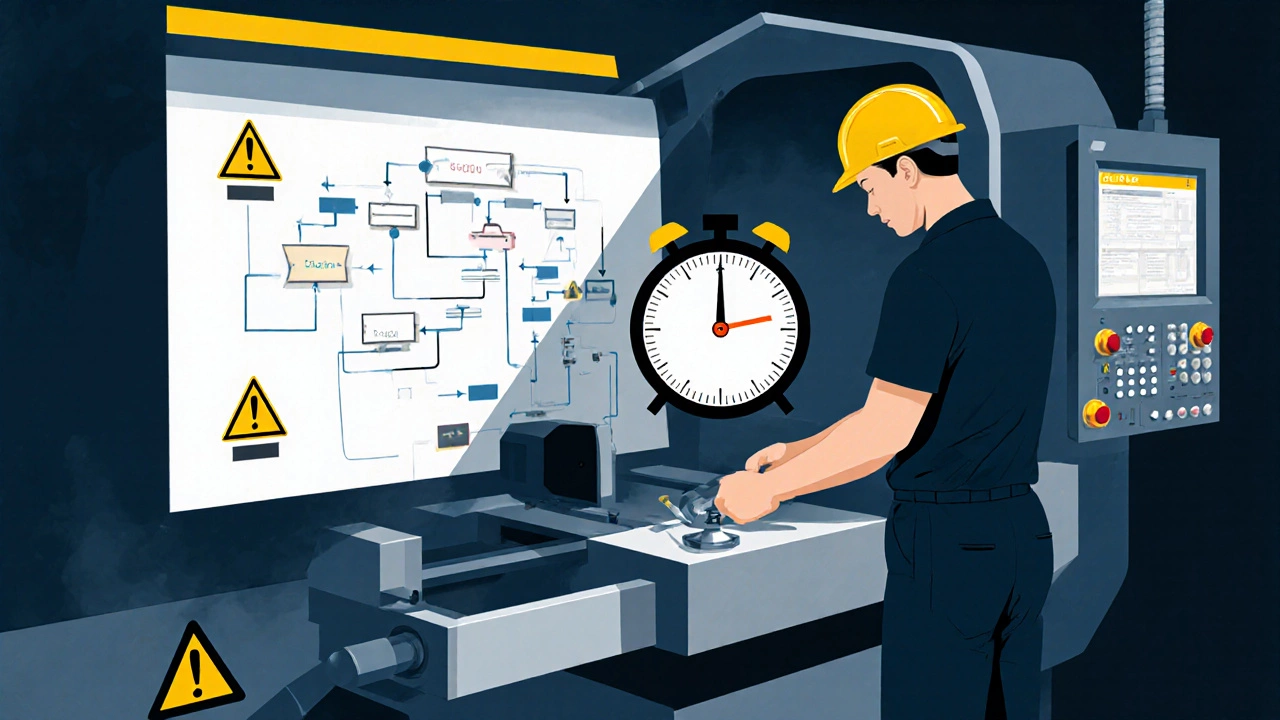5 Ps Manufacturing Assessment Tool
Rate your manufacturing operation across the 5 Ps framework. Each assessment is scored on a scale of 1-4. A higher score indicates better alignment with best practices.
0.0
Overall Score
Ever wondered why some factories churn out flawless products while others struggle to meet deadlines? The secret often lies in a simple framework called the 5 Ps of manufacturing. Mastering these five pillars helps you spot weak spots, streamline operations, and keep the line humming. Below you’ll find a no‑fluff walkthrough that takes you from definition to daily action.
Key Takeaways
- The 5 Ps - Product, Process, Plant, People, Planning - cover every critical decision point in a production system.
- Each P has measurable indicators you can track on a weekly basis.
- Aligning the Ps prevents costly re‑work, over‑stock, and missed delivery windows.
- A quick checklist lets you audit your operation in under 30 minutes.
- Common pitfalls include ignoring people’s feedback and treating planning as a one‑off task.
What Exactly Are the 5 Ps?
In the world of production, the 5 Ps act as a mental checklist that guarantees you’ve covered every angle before launching a new line or tweaking an existing one. Think of them as the five legs of a sturdy stool - remove one and the whole thing wobbles.
5 Ps of manufacturing is a framework that categorises the essential elements of a production system: Product, Process, Plant, People and Planning. The model originated in the 1970s as a response to fragmented quality efforts and has since become a staple in lean‑manufacturing courses worldwide.
1. Product - What Are You Making?
Product refers to the tangible or intangible output that the manufacturing line creates, including its specifications, design tolerances and lifecycle requirements. A clear product definition drives every downstream decision. If you don’t know the exact dimensions, material grade, or functional test criteria, you’ll end up with scrap, returns, and unhappy customers.
Practical tip: Create a one‑page product brief that lists critical dimensions, acceptable variance, and required certifications. Update it whenever engineering releases a change.
Key metrics: First‑pass yield, defect density, and specification deviation rate.

2. Process - How Do You Make It?
Process covers the sequence of operations, tooling, and control logic that transform raw material into the final product. A well‑documented process reduces variation and makes training new operators a breeze.
Map your workflow using a value‑stream map or a simple flowchart. Identify bottlenecks, redundant steps, and opportunities for automation.
Practical tip: Adopt the “single‑minute exchange of die” (SMED) principle to shave minutes off change‑over times.
Key metrics: Cycle time, overall equipment effectiveness (OEE), and change‑over duration.
3. Plant - Where Does Production Happen?
Plant refers to the physical facility, layout, and infrastructure that house the manufacturing equipment. Plant design influences material flow, safety, and capacity.
Consider cellular layouts for high‑mix, low‑volume environments, or traditional assembly lines for high‑volume, low‑mix scenarios. The right layout minimises handling and travel distance.
Practical tip: Use a digital twin to simulate layout changes before committing to costly retrofits.
Key metrics: Space utilisation ratio, material handling distance, and energy consumption per unit.
4. People - Who Operates the System?
People are the operators, engineers, supervisors and support staff who execute, monitor and improve the manufacturing process. Skills, engagement and communication directly affect quality and throughput.
Invest in cross‑training so workers can cover multiple stations, and empower them to stop the line when they spot a defect (the classic "Andon" system).
Practical tip: Introduce a weekly "kaizen hour" where teams suggest small improvements and get quick approvals.
Key metrics: Training hours per employee, safety incident rate, and suggestion implementation rate.
5. Planning - When Will Production Occur?
Planning encompasses demand forecasting, capacity scheduling, inventory control and logistics coordination. Even the best‑designed plant can’t overcome a chaotic schedule.
Combine demand signals from sales with real‑time shop‑floor data to create a rolling 12‑week master schedule. Use Material Requirements Planning (MRP) software to keep raw‑material buffers lean.
Practical tip: Run a weekly "what‑if" scenario that tests the impact of a 10% demand surge on capacity.
Key metrics: On‑time delivery (OTD), inventory turns, and forecast accuracy.

Putting the 5 Ps Into Action - A Quick Checklist
- Product definition: Verify that every new SKU has a completed product brief.
- Process mapping: Update flowcharts after any change‑over or tool modification.
- Plant layout review: Conduct a quarterly walk‑through to spot congestion or safety hazards.
- People audit: Confirm that each operator has completed the latest SOP training and has a recent safety briefing.
- Planning sync: Align the master production schedule with sales forecasts every Monday.
Ticking these boxes weekly keeps the whole system balanced and gives you a clear view of where problems are budding.
Comparison Table - Attributes of Each P
| P | Primary Focus | Typical Owner | Top Metric |
|---|---|---|---|
| Product | Specification compliance | Product Development | First‑pass yield |
| Process | Efficiency & repeatability | Process Engineer | OEE |
| Plant | Layout & capacity | Facilities Manager | Space utilisation |
| People | Skills & engagement | HR / Operations Lead | Training hours per employee |
| Planning | Demand & schedule alignment | Production Planner | On‑time delivery |
Common Pitfalls & How to Avoid Them
- Ignoring people’s input: Turn suggestions into measurable actions within two weeks; otherwise morale drops.
- Planning in silos: Use integrated software that shares forecasts with the shop floor in real time.
- Over‑engineering the product: Apply Design for Manufacture (DFM) principles early to keep costs low.
- Static plant layouts: Schedule a yearly layout audit; even small relocation of workstations can cut travel distance by 15%.
- Process drift: Implement visual controls (shadow boards, kanban cards) to keep standards front‑and‑center.
Frequently Asked Questions
Why are the 5 Ps still relevant in modern, highly automated factories?
Automation solves many mechanical bottlenecks, but it still needs a well‑defined product, a solid process, an optimised plant, skilled people, and coherent planning. Skipping any of the Ps leads to under‑utilised robots or excess downtime.
Can a small‑scale manufacturer adopt all five Ps without huge investment?
Absolutely. The framework is about mindset, not expensive tools. Simple visual work instructions cover the Process, a whiteboard schedule handles Planning, and a weekly 15‑minute Kaizen session nurtures People.
How often should the product brief be reviewed?
Any time engineering releases a change, and at least once per quarter as part of the product‑review meeting. This prevents hidden drift in tolerances.
What’s the quickest way to improve the Planning P?
Start with a simple 12‑week rolling forecast linked to a visual board on the shop floor. Seeing demand patterns daily forces better alignment than a static monthly schedule.
Is there a single software that covers all 5 Ps?
Most ERP suites integrate product data, process control, plant assets, HR, and planning modules. However, smaller firms can stitch together a best‑of‑breed stack - a PLM tool for Product, a MES for Process, a CAD‑based layout tool for Plant, an LMS for People, and a cloud‑based MRP for Planning.
By treating the 5 Ps as a living checklist rather than a one‑off analysis, you’ll catch issues before they snowball into costly downtime. Start with a single line, run the quick audit, and scale the habit across the whole operation. The result? Higher quality, tighter schedules, and a workforce that actually enjoys the job.






